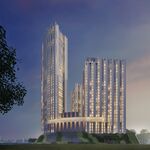I've mainly been following on the sidelines, but it seems like the argument on if an LRT project is worthwhile based on speed is a rather narrow approach. From what I recall in the early transit city proposal videos, the idea of putting up LRTs on suburban arterials such as Finch West and Jane is to make travel time more reliable during peak periods (no need to guess if it'll take you 45 minutes or 1.5 hours to go between Humber College and Finch West station, its just a 36/38 minute ride regardless of the time of day), as well as to increase the maximum capacity for the transit mode.
I've taken the 36 frequently pre-pandemic, especially during rush hour and my biggest pain points have been how crowded the buses were and having to set aside a lot more buffer time in case I either have to wait for a few buses to pass or traffic is worse than usual.
with the 36 having run at around 3.5 minute headways combined between the branches at some point, I believe there's very little gains to have dedicated bus lanes. Sure, trip times may be more reliable, but it doesn't help if you can't get on a bus due to overcrowding.




